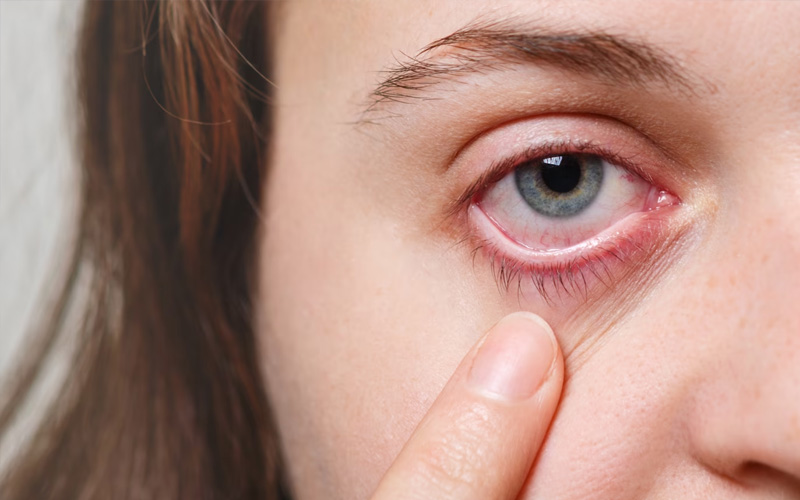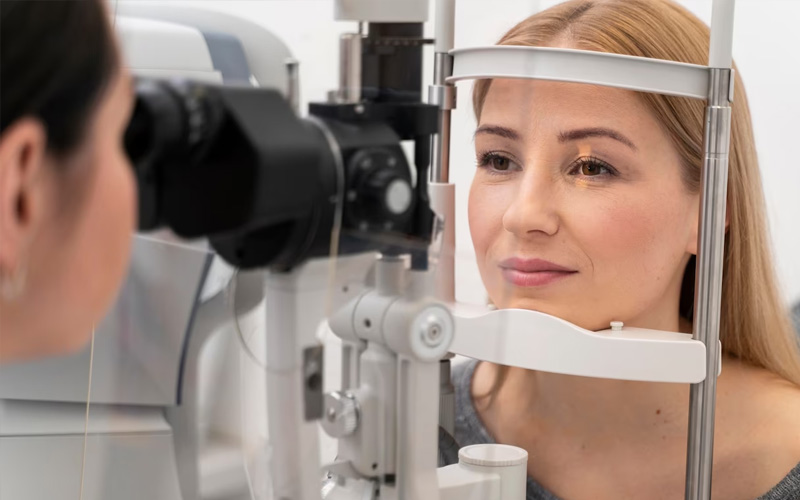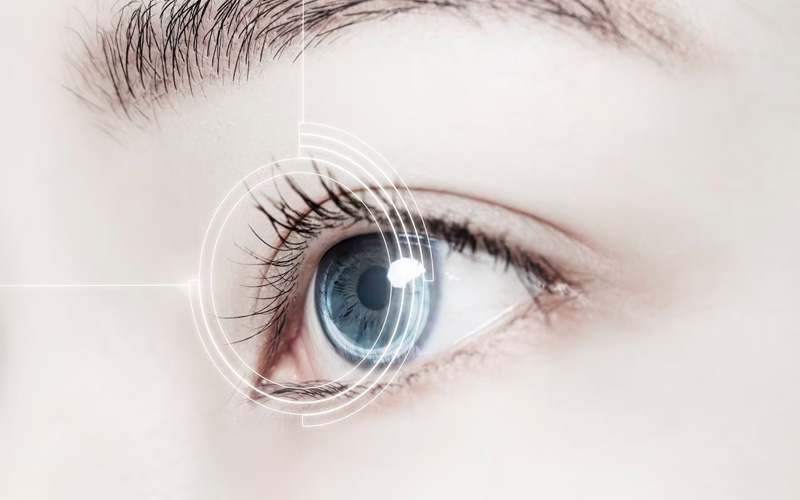Thyroid Orbitopathy (Graves’ Orbitopathy)
Thyroid disorders hold particular significance in ophthalmology due to their potential to significantly affect the eyes. The thyroid gland, which plays a crucial role in regulating the body’s metabolism, can lead to complications that impact various parts of the body, including the eyes, when its hormones are imbalanced.
In a condition known as Graves’ orbitopathy or thyroid ophthalmopathy (orbitopathy), the soft tissues around the eyes are significantly affected, putting vision at risk. This disorder is primarily autoimmune in nature, meaning it is related to the immune system attacking the body’s own tissues. It can occur not only in cases of hyperthyroidism (overactive thyroid) but also in hypothyroidism (underactive thyroid) or other thyroid dysfunctions.
In thyroid orbitopathy, the soft tissues surrounding the eyes, such as fat, muscles, and tear glands, become inflamed and swollen due to fluid retention (edema). This swelling creates pressure within the eye socket (orbit), which is the bony cavity where the eye sits. Since the orbit is confined by bone, the eyes are pushed forward, causing them to protrude (proptosis). Patients may present with abnormally wide, bulging eyes, which often appear swollen and red.
As the eye muscles responsible for movement are affected by this inflammation, symptoms like restricted eye movement and double vision (diplopia) can also occur. In severe, uncontrolled cases, the swelling can compress the optic nerve, which is responsible for transmitting visual signals from the eye to the brain. If the optic nerve becomes damaged due to prolonged pressure, irreversible vision loss or even blindness (optic atrophy) may occur, especially if treatment is delayed.
- Protruding, swollen eyes (proptosis)
- Redness and irritation in the eyes
- Double vision (diplopia)
- Restricted eye movements
- Pain or discomfort around the eyes
- In severe cases, potential vision loss due to optic nerve damage
Smoking is the most significant and nearly the only known preventable risk factor for thyroid orbitopathy. While approximately one in five thyroid patients may develop thyroid orbitopathy, this risk increases by 6-8 times in smokers. Another key preventable risk factor is maintaining balanced thyroid hormone levels. Regular blood tests and ongoing monitoring by an endocrinologist are crucial for patients with thyroid disorders.
However, even with optimal control of thyroid function through regular monitoring and maintaining ideal thyroid function test levels, the risk of developing thyroid orbitopathy remains for all thyroid patients at some stage of the disease. Therefore, early detection and management of risk factors, especially smoking cessation, are essential in reducing the severity and progression of the condition.
The symptoms of thyroid orbitopathy vary depending on the tissues affected, but the most commonly observed symptoms include:
- Red, swollen, and protruding eyes
- Redness, swelling, and puffiness of the eyelids
- Excessive opening of the eyelids and retraction (pulling back)
- Restricted eye movement and double vision (diplopia)
- Sensation of burning, stinging, excessive tearing, or dryness in the eyes
- Blurred vision
In some cases, patients may first receive a thyroid diagnosis after the appearance of eye-related symptoms. Since thyroid orbitopathy is an autoimmune disease linked to a systemic condition, it requires a multidisciplinary approach, involving internal medicine, endocrinology, and ophthalmology. Close collaboration among these specialties ensures the best outcomes for the patient.
Consulting a specialist in oculoplastic surgery is essential to preserve eye function and vision, especially in cases where these symptoms are present.
Treatment for thyroid orbitopathy varies depending on the stage of the disease, the tissues involved, and the progression of the condition. Early-stage patients may benefit from systemic and/or oral steroid treatments to reduce inflammation. In more advanced cases, surgical intervention (orbital decompression) is often necessary.
Surgical treatment can be performed for various reasons, such as improving aesthetics by restoring a protruding eye to its normal position, or more critically, relieving pressure on the optic nerve to prevent vision loss or blindness. This intervention is vital when the optic nerve is at risk due to the pressure caused by the inflammation and swelling in the eye socket.
For patients experiencing double vision (diplopia), strabismus surgery targeting the eye muscles may be required. Additionally, eyelid abnormalities, such as excessive opening, retraction, or other eyelid deformities, may require corrective eyelid surgery.
Regardless of the disease stage, it is essential that patients consult with a specialist in oculoplastic surgery who can carefully plan the appropriate surgical and/or medical treatments for optimal outcomes.
In patients with thyroid orbitopathy, surgery may become necessary at a certain stage of the disease. Orbital decompression surgery is commonly performed either to restore severely protruding eyes to their normal position or to relieve pressure on the optic nerve to prevent vision loss. The procedure aims to reduce pressure in the orbital area by expanding the bony cavity (orbit) where the eyes sit. Additionally, some of the swollen and inflamed fat tissue around the eyes may be removed to further reduce pressure. The goal is to create more space so that the eyes can settle back into their normal position without being compressed, addressing both functional and aesthetic concerns.
Orbital decompression surgery is performed under general anesthesia and may involve one or both eyes during the same session. Surgeons make micro-incisions, often through the natural folds of the eyelids or the inner part of the eyelids, to minimize visible scarring. Patients typically stay in the hospital for one or two days post-operation, and if a drain is placed, it is removed within 1-2 days. The eyes are usually not bandaged, but cold compresses and topical eye drops or ointments are recommended to reduce swelling, especially during the first few days. If stitches are used, they are removed around 10 days after surgery.
Orbital decompression generally provides long-lasting, positive results, and in some cases, it is performed urgently to relieve immediate pressure on the optic nerve. Since it is a highly specialized and delicate procedure, the best outcomes are achieved when performed by an oculoplastic surgeon who is experienced in both thyroid orbitopathy and decompression surgery.









